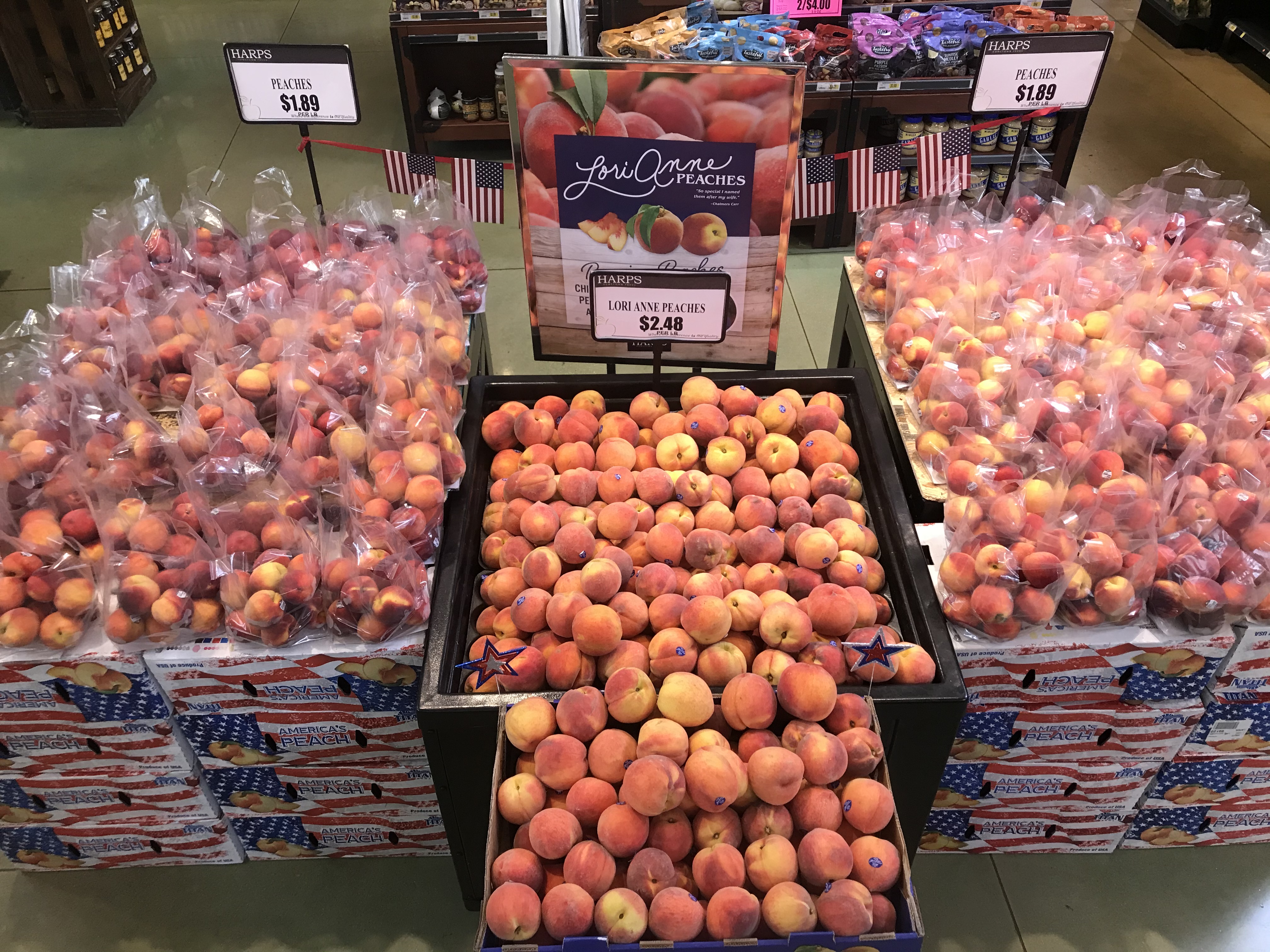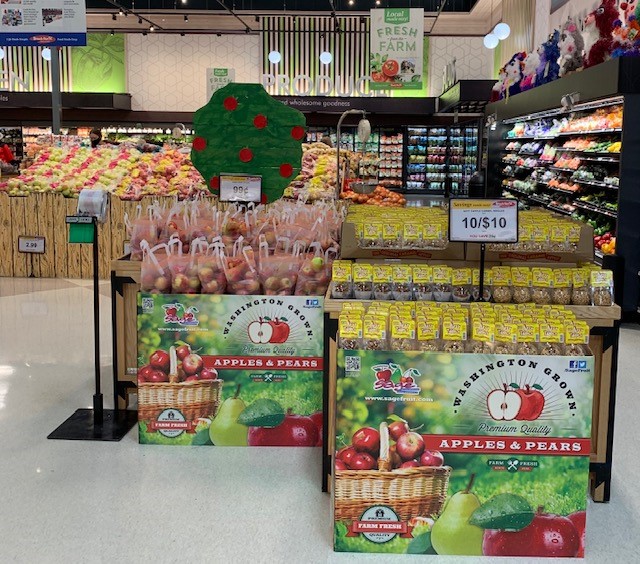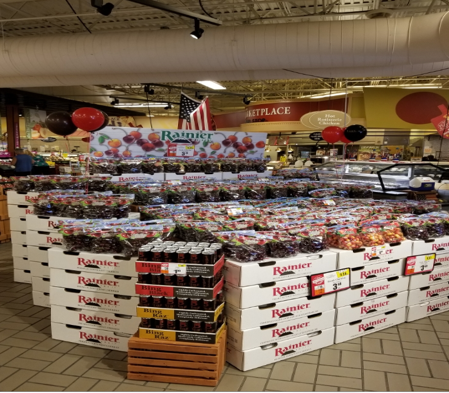Photo submitted by Horace Fuller with HAC for PMG's Produce Artist Award Series
Many retailers appreciate the opportunity to tell their shoppers more about products through supplier-provided point-of-sale material, but it all comes down to execution and the context of the department.
“For us it's one at a time,” said Price Mabry, director of produce and floral for Oklahoma City-based HAC, which operates banners including Homeland, United Supermarkets and Cash Saver. “It's Vidalia season right now, so we want every customer that walks in the store to know we're seasonally correct with Vidalia onions, so we do have vendor POS out of the floor supporting that, and as we move through the season we'll take that down, replace it, most likely with some type of soft fruit (POS material).”
Mike Roberts, director of produce operations for Springdale, Ark.-based Harps Food Stores, is similarly inclined. Harps uses pop-up bins from time to time but tries to keep them to a minimum, Roberts said.

“We want to make sure that we're using them for the right item, the right season,” Roberts said. “I don't ever want to see a bin of something for cantaloupes in the winter still up in my stores because that gets a little embarrassing and probably there's not going to be cantaloupes in it.”
The company is happy to promote its vendors, he added, but on the sales floor they try to make it mostly about Harps.
Jeff Cady, director of produce and floral for Williamsville, N.Y.-based Tops Friendly Markets, also noted seasonality as a key consideration related to point-of-sale material.
“There has to be a beginning and an end,” Cady said.
In general, though, he likes to use point-of-sale material when possible.
“I believe in using the display vehicles and the communication things that they offer,” Cady said. “I think that you only have so many opportunities to communicate message to the consumer, and in my opinion what better place than at the point of sale.”
The 24-inch-wide, 18-inch-deep display bins with a great picture of the product and a message or two are Cady's favorite option because they can give a featured item a secondary presence.
“It helps create that special look,” Cady said. “I don't just want it to blend in because, if it blends in, it just becomes part of the furniture and it's another chair to sit in or whatever. I like to bring it out of the display.
“I want it out away from the category or out where it can be a point of interruption,” Cady said. “Utopia would be by the front registers, or if you're going to put something over by the ice cream depending on if it's a fruit, or over by the meat department. Like with the onions, there are a couple companies that do a real nice job with those onion bins, and we put them right over there and they're spectacular, really kind of send that message to the consumer of what you can do and help kind of complete that shop, fill that basket.”
Danny Hulslander, produce category manager for Prichard, Ala.-based Greer's Markets, also embraces point-of-sale material. He gave as an example the orchard trees, trains and other displays that Los Angeles-based The Wonderful Co. provides to help retailers promote its Halos mandarins.
“I learned from a long time ago from one of my mentors in the business that companies that put that stuff out did it for a reason, and they spend millions of dollars on that stuff, so why would you not take advantage of it?” Hulslander said.
“So my theory is that if they offer it, we use it, so if they offer POS materials and bins and any POS that helps us move product, then I'm all for it because I think it lends to the experience of what the shopper's trying to buy also," Hulslander said. "A lot of people are buying name-brand stuff these days.”
Bob Hylka, director of produce for Highland, Ind.-based Indiana Grocery Group, which operates the Strack & Van Til and Town & Country banners, said he likes point-of-sale material particularly for waterfall or side displays.

“The challenge as a merchant is to avoid overuse of POS,” Hylka said. “For our stores it works best when combined with our internal signage for some consistency.
“While we don't have a clean floor policy per se, we do create internal signage for new products, product lines and especially for locally grown or locally produced items,” Hylka said. “We try to fit in some informational bits, too, whether it's flavor profiles, suggested uses or simple geography.”
Michael Schutt, director of produce and floral for West Sacramento, Calif.-based Raley's, approaches point-of-sale opportunities on a case-by-case basis.
“The one hard-and-fast rule that we have or that we employ at least with produce specifically is we want the product to be the star of the show,” Schutt said. “That's the customer-facing piece of it, and so any of the POS material and things like that needs to be a little bit more muted and something that's really just pushing the product out front first.”
He suggested that one way to provide additional information for shoppers at the point of sale could be with QR codes. They were a relatively short-lived trend years ago but made a resurgence during the pandemic as restaurants used them in lieu of menus. In addition, while QR codes of old required installing an app, now all that's needed is the built-in camera function of the average smartphone.
“Now that everybody has a different level of usage and maybe comfortability, is that something that might kind of become retro and allow you to go into the produce department and click on maybe a smaller POS (piece) but get a deeper dive into maybe a grower story or a shipper story without having all of that in your face at the point of sale,” Schutt said.
Mabry mentioned QR codes as well. Recipes are the most useful type of information for shoppers at he point of sale, followed by product details and grower stories, he said.

“We really like to promote recipes,” Mabry said. “If there's a QR code they can scan and it goes to a recipe, we really want to tie in the other departments and things like that, so that's first. We want it to drive sales – that's the point of having it out here.
“And then two is to (create) the connection with the consumer to the farmer, and not only the consumer but our produce manager,” Mabry said. “A lot of these produce managers, they're as far away from the farmer as the consumer is, so it's really those folks understanding what it takes to grow it, produce it, ship it, pack it, get it to our store, that's number two, and then number three is … the story. It's so neat to see some of these family farms out there and the story behind it, third-generation, fourth-generation, things like that.”
Hylka noted that rotating in and out branded boxes and bins can help keep the department looking fresh – and having some extra on hand is helpful in case a display gets hit by a wayward shopping cart.
Point-of-sale is particularly useful for product launches and the beginning of a season, plus whenever an ad feature warrants a big display with some extra touches.

“Building a display and sending a picture out to all stores prior to the ad break can help give managers that may be less creative a blueprint,” Hylka said. “Previous display pics can help, too.”
Hulslander said slower sales periods can also be a great time to use point-of-sale material because it adds a little extra interest to engage shoppers.









